A Guide to Startup MVP Development Services
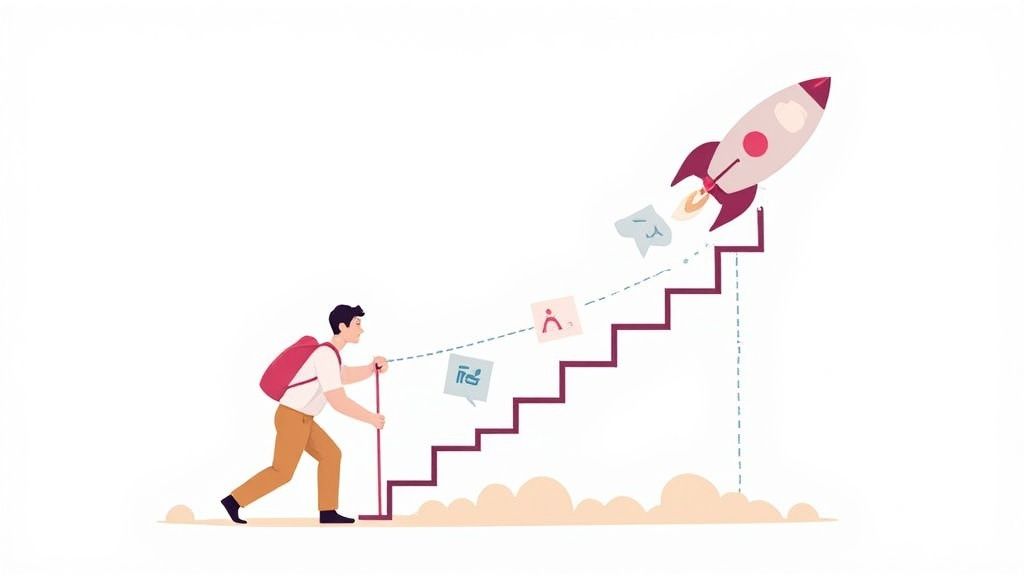
Every founder starts with a spark. That brilliant, intoxicating idea that feels destined to change the world. I know the feeling. The late nights sketching user flows on a whiteboard, so sure you've cracked the code for the next big thing.
That energy is a founder's superpower, but if we're being honest, it can also be a little dangerous.
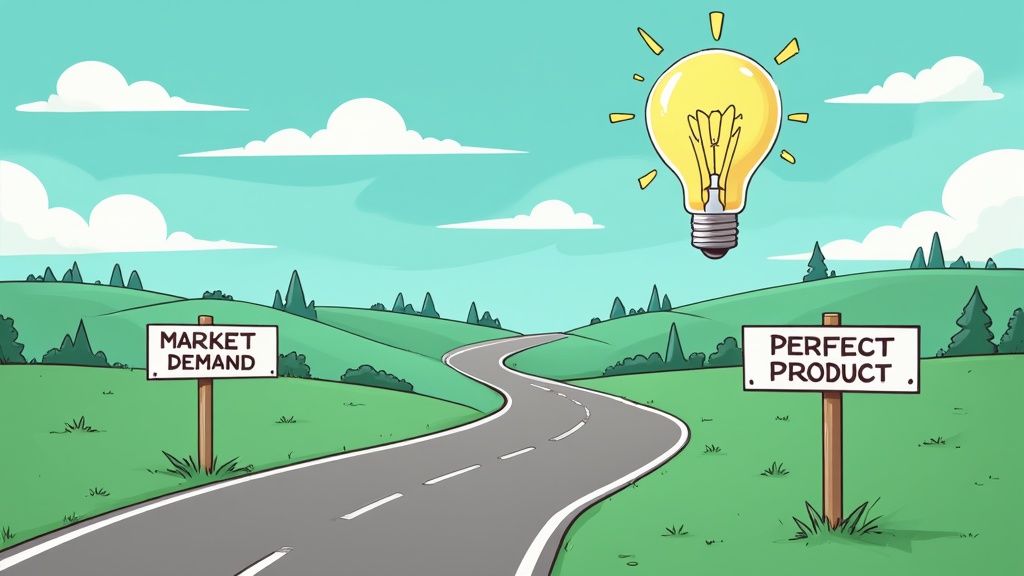
There's a classic startup trap, a ghost story told around the virtual campfire. It's the story of the team that builds a perfect, feature loaded product in a quiet vacuum, only to launch it to the sound of crickets. This "build it and they will come" fantasy is one of the most common reasons new ventures go under. A staggering 35% of startups fail simply because there's no market need for what they built. It's a heartbreaking end for anyone who poured their soul, time, and savings into an idea.
This is the real puzzle, isn't it? Bridging that massive canyon between a great idea and something people will actually use. How can you possibly know if people will use, let alone pay for, your solution before you sink everything into building the whole grand vision?
A Smarter Path Forward
Instead of taking that massive leap of faith, there's a more strategic, less terrifying way to move forward. This is where startup MVP development services come into play. An MVP, or Minimum Viable Product, isn't about building something cheap or unfinished. Far from it.
Let's try an analogy. You want to build the first rocket to Mars. The temptation is to build the whole thing: the crew quarters, the science labs, the fancy paint job. But a smarter way is to start with the command module and the engine, the absolute essentials needed to prove you can get into orbit. You gather real world data and then you decide how to build the rest of the ship.
An MVP is laser focused on answering one crucial question: Is this idea really worth pursuing? It does this by:
- Validating Core Assumptions: It puts your most critical hypotheses about your users and their problems to the test with a real, functioning product.
- Gathering Real User Feedback: It gets something tangible into the hands of early adopters to see how they actually behave, not just how they say they'll behave.
- Reducing Upfront Investment: By focusing only on must have features, you dramatically lower your initial development costs and get to market much, much faster.
Ultimately, the goal is to measure product-market fit with your MVP. This cycle of building, measuring, and learning is the bedrock of smart product development. If you're just starting out, it's a good idea to ground yourself in the core things to know before starting a startup to make sure your strategic foundation is solid from day one.
What Exactly Are Startup MVP Development Services?
Let's pause and clear the air on the term 'MVP'. When people hear "Minimum Viable Product," their minds often jump to something cheap, half baked, or rushed out the door. That's a huge misconception and couldn't be further from the truth.
Think of it this way. Imagine you have a revolutionary idea for an electric car. The temptation is to go all in from day one: design the self driving AI, the panoramic sunroof, the fancy entertainment system. But that's a multimillion dollar gamble that takes years before you even know if anyone actually wants to drive your car.
A much sharper approach is to focus on the absolute core of the idea. Build a solid chassis, a reliable battery, and an efficient motor. That's your MVP. It's not the finished luxury sedan, but it's a real, functional vehicle that proves your core tech works. It gets your first users from point A to point B, and their feedback tells you exactly what features to build next.
Startup MVP development services are the teams, the specialized engineers and product strategists, who help you build that core version of your product. They do more than just write code; they guide you through a disciplined process of turning your assumptions into validated facts.
The Build, Measure, Learn Feedback Loop
The whole philosophy behind an MVP boils down to a simple but powerful cycle: "build, measure, learn." This isn't just a buzzword; it's a framework for reducing risk and maximizing what you learn from every dollar and hour you invest. For a great deep dive on this foundational concept, check out this guide on MVP development for startups.
This diagram perfectly captures the flow: you validate your core ideas, build the smallest possible product to test them, and then gather real user feedback to inform the next step.
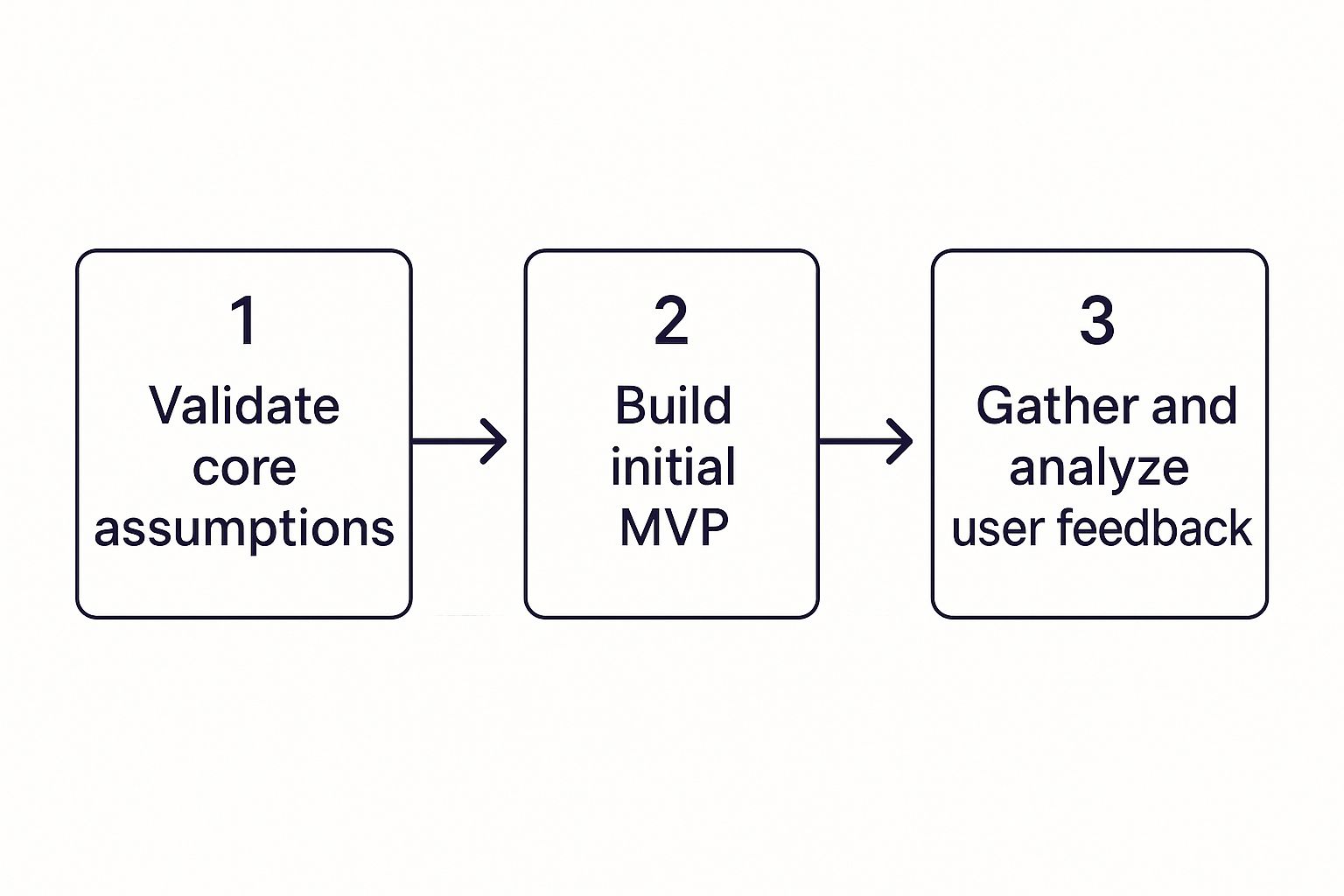
This loop isn't a one and done deal. It's the engine that continuously powers your product's evolution, making sure you're building based on hard data, not just what you think is a good idea in a meeting room.
This structured process is precisely why so many successful companies start this way. The data speaks for itself: 72% of startups use MVPs to cut costs by up to 60% and slash their time to market by 35%. The result? A 50% increase in sustainable revenue.
When you consider that 42% of startups fail because they build something nobody needs, the MVP stops being a choice and starts looking like a critical survival strategy.
To really nail this down, it's helpful to see how an MVP stacks up against a full scale product launch.
| Aspect | MVP Approach (Learning First) | Full Product Approach (Launch First) |
|---|---|---|
| Primary Goal | Validate a core assumption and learn from real users. The main product is learning. | Launch a complete, feature rich product to capture market share. The main product is the software. |
| Scope & Features | Minimal. Only the essential features needed to solve one key problem for a specific user group. | Extensive. A broad set of features designed to appeal to a wide audience from day one. |
| Time to Market | Weeks or a few months. Speed is critical to start the feedback loop. | Many months, often years. Development cycles are long and complex. |
| Initial Investment | Low. The goal is to spend as little as possible to get validated learning. | High. Requires significant upfront investment in development, marketing, and infrastructure. |
| Risk Profile | Low. Failure is small, cheap, and provides valuable lessons for the next iteration. | High. If the core assumptions are wrong, the entire investment is at risk. |
| Target Audience | Early adopters. Visionary customers who are willing to tolerate imperfections to solve a painful problem. | Mass market. The product must be polished and stable enough for the general public. |
| Outcome | A validated (or invalidated) hypothesis and a clear, data driven roadmap for what to build next. | A full featured product in the market, along with pressure to gain traction and prove ROI. |
This table highlights the fundamental mindset shift: an MVP prioritizes learning and risk reduction over a big, splashy launch.
What an MVP Is Not
Before we go deeper, here's what you should have in mind. An MVP is not:
- A prototype. A prototype is usually a non functional mock up, like a clickable wireframe, used to test a user interface. An MVP is a working piece of software that real people can use to solve a real problem.
- The first version of your final product. Think of an MVP as a learning vehicle. The insights you get from it will almost certainly change the direction of your final product. What you think users want is rarely what they actually want.
- An excuse for poor quality. "Minimum" applies to the scope of features, not the quality of the engineering. To get reliable feedback, your MVP has to be stable and usable. A buggy product just teaches you that people don't like bugs.
A Minimum Viable Product must be exactly that: Viable. It has to solve at least one core problem for your target user so well that they're willing to use it, and give you feedback, even though it's missing a bunch of other features.
This is the key distinction. You're not trying to launch something that's half finished. You're launching the smallest possible thing that can kickstart the learning process with actual customers. That disciplined focus is what separates a smart pivot from a costly failure.
Navigating the MVP Development Journey
Kicking off a Minimum Viable Product can feel a lot like planning a cross country road trip. You know the destination, a successful product, but the actual route is packed with twists, turns, and a whole lot of unknowns. You wouldn't just jump in the car and start driving without a map, right? The same logic applies here; you don't start writing code without a clear, strategic plan.
This whole process isn't a chaotic sprint to the finish line. It's a structured journey, a series of deliberate steps designed to answer critical questions and get you closer to your goal, armed with real world learning every step of the way.
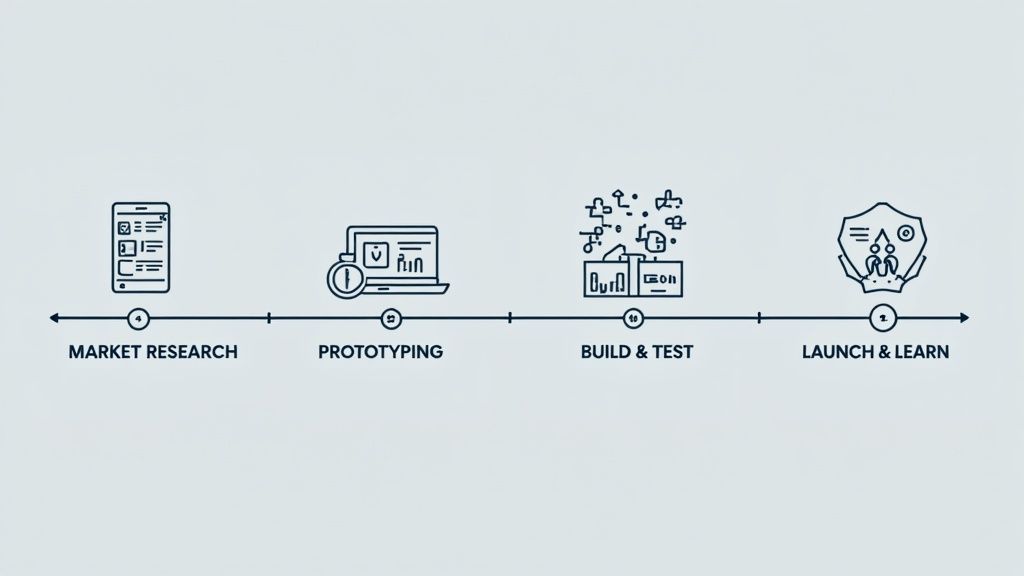
Let's break down the key milestones on this map. We'll go from that first spark of an idea all the way to analyzing the invaluable data from your very first users. Each stage is non negotiable if you want to build a product that doesn't just work, but one that people actually want to use.
Stage 1: Market Research and Idea Validation
Before a single line of code gets written, you have to confirm your core hypothesis. It sounds incredibly obvious, but you'd be surprised how many enthusiastic founders skip this step in their rush to just build something. This is where you put your ego on a shelf and become a detective.
The central question you're trying to answer is: "Are we solving a real, painful problem for a specific group of people?" Answering this means getting out of the office. It means talking to potential users, running surveys, and taking a hard look at what your competitors are doing (and not doing).
Your goal is to gather cold, hard evidence that your idea has legs. Without this validation, you're building on a foundation of pure guesswork, which is just a recipe for wasting a ton of time and money.
The most expensive way to learn if your idea is good is by building the entire product first. The cheapest way is to talk to your customers before you even have a product.
This initial phase sets the direction for everything that follows. It ensures you're pointed toward a genuine market need, not just building a cool solution that's desperately searching for a problem to solve.
Stage 2: Feature Prioritization and Prototyping
Okay, so you've validated that the problem is real. Now comes the next challenge: deciding what, exactly, to build. This is where the "Minimum" in MVP becomes absolutely critical. The temptation to add "just one more feature" is a powerful one, but it's a trap that leads straight to scope creep and delayed launches.
This is where prioritization frameworks become your best friend. A popular and incredibly effective one is the MoSCoW method:
- Must Have: These are the non negotiable, core features. Without them, the product simply doesn't function. If you're building a ride sharing app, the ability to request a ride is a Must Have.
- Should Have: Important features that aren't absolutely essential for the first launch. Think of things like seeing a driver's rating or past trips.
- Could Have: These are the "nice to have" features that can easily be pushed to a later version. An example might be the ability to split a fare with a friend.
- Won't Have (This Time): Features that you explicitly decide are out of scope for this version. This is crucial for keeping the team focused.
Categorizing features like this creates a ruthless focus on what truly matters for version one. That kind of clarity is gold, especially when you start mapping out timelines. For a deeper dive, check out our guide to a realistic software project estimate, which is great for aligning your feature scope with practical deadlines.
After prioritizing, you jump into prototyping. This means creating wireframes or interactive mockups to visualize how a user will actually move through your app. A prototype lets you test the user experience and get feedback before a single dollar is spent on development.
Stage 3: Build and Test
With a validated idea in one hand and a prioritized feature list in the other, it's finally time to build. This phase is best handled using agile development methods, specifically by working in short cycles called sprints.
Each sprint, usually lasting one to two weeks, focuses on building a small, functional piece of the product. This iterative approach pays off in a few key ways:
- Continuous Feedback: At the end of each sprint, you have something to show stakeholders and even early users. This lets you course correct quickly if you're heading in the wrong direction.
- Flexibility: If you learn something new that changes your priorities, you can adjust the plan for the next sprint without derailing the whole project.
- Momentum: Seeing tangible progress every couple of weeks is a huge motivator and keeps the entire team focused and energized.
And testing isn't some final step you tack on at the end; it's woven directly into every sprint. This covers everything from unit tests written by developers to user acceptance testing where real people interact with the new features. You need a stable, usable MVP to get reliable feedback.
Stage 4: Launch and Learn
The launch of your MVP isn't the finish line, it's the starting line. This is where the most important phase begins: learning. Your goal now is to get the product into the hands of your early adopters and meticulously collect data on how they're actually using it.
This is the "measure" part of the classic "build, measure, learn" loop. You need to track key metrics that tell you whether you're on the right track or need to pivot.
These metrics could include things like:
- User Engagement: How often are people logging in? Which features are they using the most? Which ones are they ignoring?
- Conversion Rates: Are users signing up? Are they completing the core action you designed the product for?
- User Feedback: What are people saying in support tickets, surveys, and one on one interviews?
The data you collect here is pure gold. It gives you objective, evidence based insights to guide your next set of decisions. This is the information that will tell you whether to persevere with your current strategy, pivot to a new one, or add the next set of features based on real, demonstrated demand. This cycle of launching, learning, and iterating is the very heart of what makes startup MVP development services so powerful for new ventures.
How to Choose the Right MVP Development Partner
Picking a team to build your Minimum Viable Product is a bit like choosing a cofounder. It's a massive decision, and the stakes are incredibly high. You aren't just outsourcing a coding project; you're handing over your vision to a partner who will help pour its very foundation.
A cheap or inexperienced team might deliver some code, sure. But a great partner delivers strategy. They become a genuine extension of your own team, challenging your assumptions, pushing for clarity, and obsessing over the user experience right alongside you. Get this choice right, and you dramatically boost your odds of success. Get it wrong, and you could burn through your entire budget with very little to show for it.
Beyond the Technical Checklist
Of course, technical skill is the baseline. You absolutely need a team that knows their way around the right technology stack. But honestly, that's just the price of entry. The real differentiators are the less tangible qualities that separate a simple vendor from a true strategic partner.
It's one thing to know how to build something; it's another thing entirely to understand why you're building it. A great team gets this distinction. They'll grill you with tough questions about your business model, your target user, and your validation metrics. If a potential partner isn't curious about these things, that's a huge red flag. They should care as much about your business outcomes as you do. This mindset also shapes their approach to your product's architecture. To help frame this part of the conversation, you can check out our guide on how to choose a technology stack without losing your mind.
Key Areas to Evaluate
When you start vetting potential startup mvp development services, you need a framework to guide your conversations. This isn't just about flipping through portfolios; it's about digging deep into their process, their communication style, and their whole philosophy on building products.
Here are the critical areas to focus on:
- Proven Industry Experience: Have they actually built products in your industry before? A team that gets the subtle nuances of fintech, for example, will be miles ahead of a generalist agency when it comes to things like compliance and user expectations.
- A Clear Development Process: Ask them to walk you through their entire process, from that first discovery call to launch day. Do they practice agile development? How do they handle sprint planning, feedback loops, and testing? You want to hear a well oiled machine, not a team that's just winging it.
- Strong Communication Practices: How will you stay in the loop? Look for a solid commitment to regular, transparent communication, whether that means daily standups, weekly demos, or a shared project management tool like Jira or Trello. Misunderstandings are expensive, and clear communication is the best prevention.
- Strategic and Business Acumen: Do they think like founders? A partner who can offer strategic advice, not just execute on a list of features, is invaluable. They should feel like a strategic advisor, not just a hired gun.
The demand for these specialized services is blowing up. The global MVP development market, valued at around USD 316 million in 2024, is projected to rocket to USD 569 million by 2031. This growth shows just how vital this lean, cost effective approach has become for startups trying to validate their ideas in a brutal market. You can read the full research about the MVP market growth for more of the numbers.
Your ideal partner is a team that isn't afraid to tell you when an idea is bad. They should be more committed to your long term success than to simply nodding along with everything you say.
This kind of brutally honest partnership is what separates a successful MVP journey from a frustrating, money draining one. You want a team that will build your product with you, not just for you. That collaborative spirit is the secret ingredient that turns a simple project into a powerful launchpad for your entire business.
Checklist for Evaluating MVP Development Partners
To make your decision process a bit more structured, here's a checklist to help you compare potential partners on the factors that truly matter. It goes beyond just looking at the price tag and helps you uncover the quality of the team you'd be working with.
| Evaluation Criteria | What to Look For | Red Flags to Watch For |
|---|---|---|
| Strategic Input | Do they ask "why?" and challenge your assumptions? Do they offer suggestions to improve your business model or user flow? | Immediately agreeing to build whatever you ask without questioning the business logic. "Yes men" who just want the contract. |
| Process Transparency | A well defined, agile process (e.g., Scrum, Kanban). Clear roles, regular ceremonies (standups, demos), and visible progress. | Vague or non existent process. Phrases like "we're flexible" without any structure behind it. No access to project tools. |
| Communication Style | Proactive updates, a dedicated point of contact, and a commitment to regular, scheduled meetings. Clear, concise language. | Slow response times, getting passed around to different people, or communication that is overly technical and unclear. |
| Portfolio Relevance | Have they solved similar problems or built products for a similar user base, even if not in your exact industry? | A portfolio full of simple marketing websites when you need a complex SaaS platform. No demonstrable results or case studies. |
| Team Composition | Direct access to the developers, designers, and PMs who will actually be working on your project. A balanced, senior team. | A sales heavy team with little access to the actual builders. Vague answers about who will be on your project. |
| Post Launch Support | Clear options for maintenance, bug fixes, and future development phases. A plan for a smooth handover if needed. | No discussion about what happens after launch. Evasive answers about long term partnership or support costs. |
Using a checklist like this helps you stay objective. It's easy to get swayed by a slick sales pitch, but the answers to these questions will reveal the true character and capability of a potential partner. The goal is to find a team that aligns not just with your technical needs, but with your vision and values for the long haul.
Common Mistakes to Avoid in MVP Development
The journey to launch a Minimum Viable Product is exciting, but it's a path littered with hidden traps. I've seen brilliant founders with amazing ideas get sidetracked by a few common, but costly, mistakes. Think of this as a map of those obstacles, designed to help you navigate around them and save you a world of headaches.

Successfully launching an MVP is less about avoiding every single error and more about recognizing the major ones before they derail your progress. Let's walk through the three most common pitfalls I see teams fall into.
The Siren Song of Scope Creep
This is the big one. Scope creep is the slow, insidious process of adding "just one more feature" until your "minimum" product is no longer minimum. It often starts with good intentions. A great idea pops up in a brainstorming session, a stakeholder makes a compelling request, or you worry the product won't be "good enough" without that extra bell or whistle.
I once worked with a startup building a simple project management tool. Their core feature was a unique way to visualize task dependencies. But over a few months, they added team chat, then calendar integrations, then detailed reporting. Their three month MVP timeline ballooned to nine months, their budget was torched, and a competitor launched a simpler, more focused product in the meantime. They tried to build a Swiss Army knife when their users just needed a sharp blade.
The discipline of an MVP is defined by what you bravely choose not to build. Every feature you add is a tax on your time, budget, and ability to learn quickly.
To avoid this, be ruthless with your MoSCoW prioritization. If it's not a "Must Have" for validating your core hypothesis, it goes on the backlog for later. No exceptions.
Ignoring the Feedback You Don't Like
You've launched! The data is rolling in, and the user feedback has started. But what happens when the feedback tells you something you don't want to hear? It's human nature to look for validation, to seek out the comments that confirm our original vision.
Ignoring negative feedback or dismissing it as "users just not getting it" is a fatal error. Your MVP is not a final exam; it's a science experiment. Its entire purpose is to generate data, and that data, good or bad, is the most valuable asset you have. If 60% of users are struggling with your onboarding flow, that's not their fault. It's a clear signal that your onboarding needs a rethink.
The cost of this mistake isn't just a flawed product; it's a massive financial risk. Smart startup mvp development services focus on building feedback loops right into the process. The financial benefit is clear, as an MVP typically requires only 10 to 30% of the resources needed for a full product, significantly reducing your upfront burn. To get a better handle on the numbers, you can learn more about MVP development costs and see how this approach saves capital for what truly matters.
Getting Stuck in Analysis Paralysis
The opposite of scope creep, but just as dangerous, is analysis paralysis. This is when you get so caught up in planning, researching, and debating that you never actually build anything. You spend weeks perfecting the business plan, endlessly tweaking wireframes, and holding meeting after meeting to discuss the "perfect" tech stack.
While planning is essential, the MVP philosophy is biased toward action. You learn more from a week of real user interaction with a basic product than you do from three months of theoretical planning. Remember, your goal is not to launch a flawless product; it's to start the "build, measure, learn" cycle as quickly as possible. Don't let the quest for perfection become the enemy of progress. Get something viable out the door and let the market be your guide.
We've covered a lot of ground, from the first flicker of an idea to the brass tacks of building and launching a Minimum Viable Product. It's easy to get lost in the weeds, but the whole process really hangs on just a few critical ideas.
Think of this as your cheat sheet. The stuff you tape to your monitor to keep you honest while you build.
Learning is the Real Goal
The number one, non negotiable purpose of your MVP isn't to rake in cash or hit a thousand users on day one. It's to learn. Every single feature you build, every dollar you spend, should be laser focused on answering your biggest, scariest business questions.
An MVP isn't a product; it's an experiment. It's a tool you use to drag your assumptions out of your head and test them against the harsh reality of the market. Every piece of user feedback, good, bad, or brutal, is a precious data point.
Getting this mindset right changes everything. It reframes "failures" as lessons learned, steering you away from what you think people want and toward what they'll actually pay for.
Get Ruthless About Simplicity
The "Minimum" in MVP is where the magic happens. It's a forcing function for discipline and focus.
Here's how you stay on track:
- Solve One Problem, Perfectly: Fight the temptation to build a Swiss Army knife. Find the single most painful problem your target user has and create the sharpest, most effective solution for it.
- Define "Done" for Version One: Be brutally honest about what's essential. A framework like MoSCoW (Must Have, Should Have, Could Have, Won't Have) is great for this. Have the courage to push almost everything into the "Won't Have" pile for now.
- Speed is Your Secret Weapon: The quicker you launch, the quicker you can kick off that all important "build, measure, learn" feedback loop. This is where the real work begins.
Your Development Partner is a Strategic Choice
Finally, don't forget that great startup mvp development services are much more than just coders for hire. You're not just buying code; you're bringing on a strategic partner who should feel like an extension of your founding team.
You want a team that pushes back, that challenges your assumptions, and that brings real business smarts to the table. The right partner isn't afraid to tell you an idea is bad, because they're just as invested in your long term success as you are.
Got Questions? Let's Talk Brass Tacks.
Even with a solid plan, jumping into the world of Minimum Viable Products can feel like learning a new language. You've got questions, and that's a great sign, it means you're thinking like a strategist. Let's get into some of the most common ones I hear from founders exploring startup mvp development services.
My goal here isn't to give you textbook definitions, but the real world, practical context I've seen play out over and over again.
So, How Much Should an MVP Really Cost?
This is always the first question, and the honest answer is: it depends. I know, not what you wanted to hear, but it's the truth. The cost is a direct reflection of complexity.
A simple MVP with a core feature set and a straightforward tech stack might land somewhere in the $10,000 to $50,000 range. But if your idea leans on more advanced tech like AI, machine learning, or requires tricky third party integrations, the budget can easily stretch north of $150,000.
Here's the key: that's still just a fraction of what a full blown product would cost. Some estimates show an MVP requires only 10 to 30% of the resources of a full build. The real goal isn't finding the cheapest developer, but the one who can deliver the most learning for the leanest possible investment.
How Long Does This Actually Take to Build?
Speed is your superpower here. The whole point of an MVP is to get into that "build measure learn" loop as fast as humanly possible.
A typical, well defined MVP usually takes about three to four months from the first line of code to launch. It can be quicker for super simple products or a bit longer if there are serious technical hurdles to overcome. If you find yourself pushing past the six month mark, it's a red flag that your MVP probably isn't "minimum" anymore, scope creep has likely snuck in.
The timeline really boils down to three things:
- Feature Complexity: Just how much do those "must have" features actually entail?
- Team Size and Experience: A small, seasoned team that's done this before will move much faster.
- Founder Availability: Your ability to give quick, decisive feedback is the grease that keeps the wheels turning. Slow decisions kill momentum.
We Launched the MVP… Now What?
Launching your MVP isn't the finish line, it's the starting gun. Seriously. The real work, the most important work, starts the moment it goes live. Your focus instantly flips from building to learning.
This is when you obsessively track user behavior, get on calls to gather raw feedback, and dive into the data to see if your core assumptions were right. Based on what you discover, your next move will generally fall into one of three buckets:
- Persevere: The data is good. Your core hypothesis is validated. You double down on the current strategy and start building the next set of prioritized features.
- Pivot: Your initial idea was off, but the user data points to a different, more promising opportunity. You change direction to chase this new path.
- Pause: The feedback is overwhelmingly negative, and there's no clear pivot. This might be the time to shelve the idea, knowing you spent far less than you would have on a full product.
The entire job of the MVP is to give you the clarity to make one of these calls with confidence, backed by real world proof instead of just a hunch.
Ready to turn your idea into a validated, market ready product? As a full stack engineering consultant, Kuldeep Pisda specializes in helping early stage startups build robust, scalable MVPs and accelerate their technical roadmaps. Let's build something that matters. Explore consulting engagements.
Subscribe to our newsletter.
Become a subscriber receive the latest updates in your inbox.


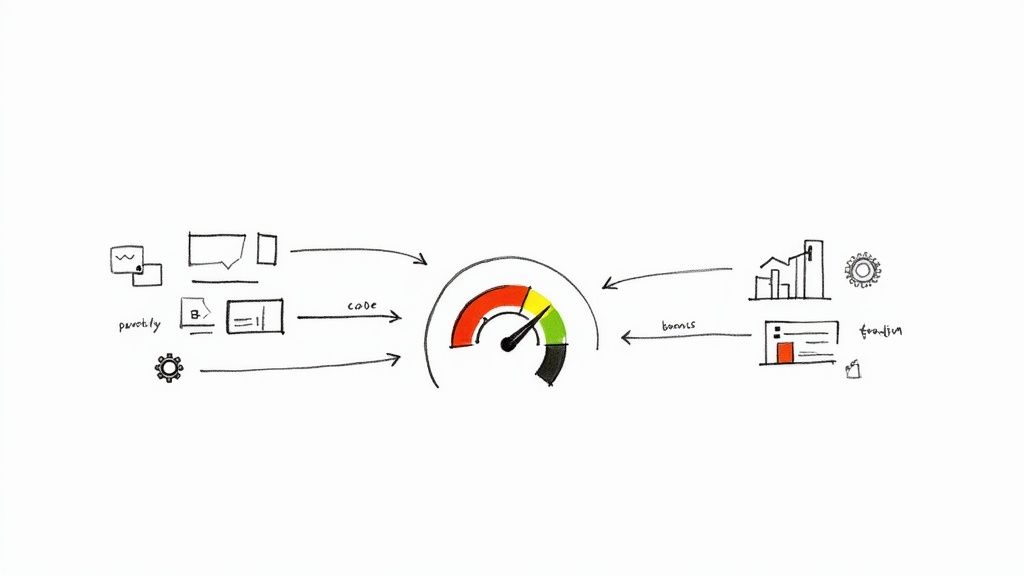
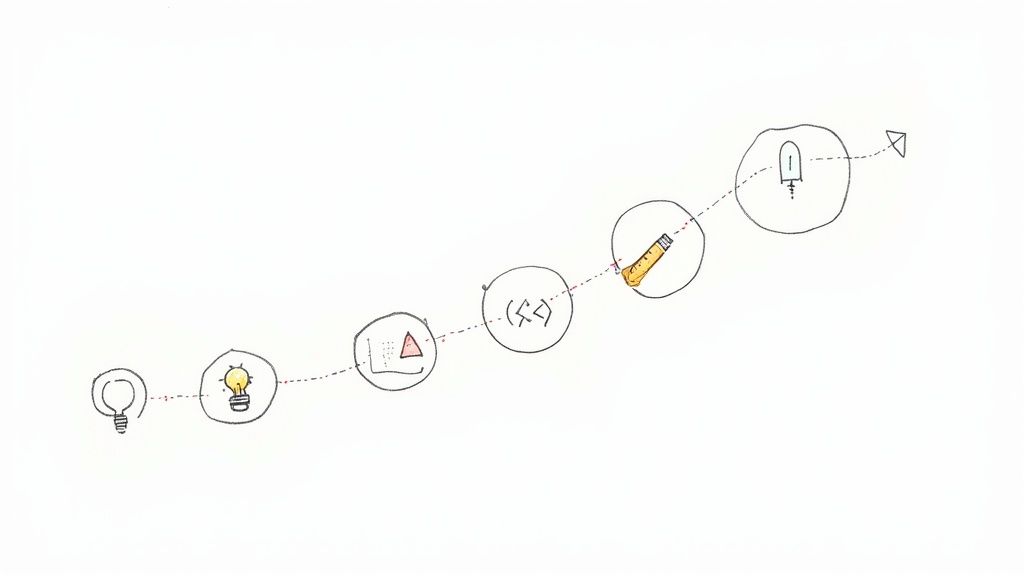
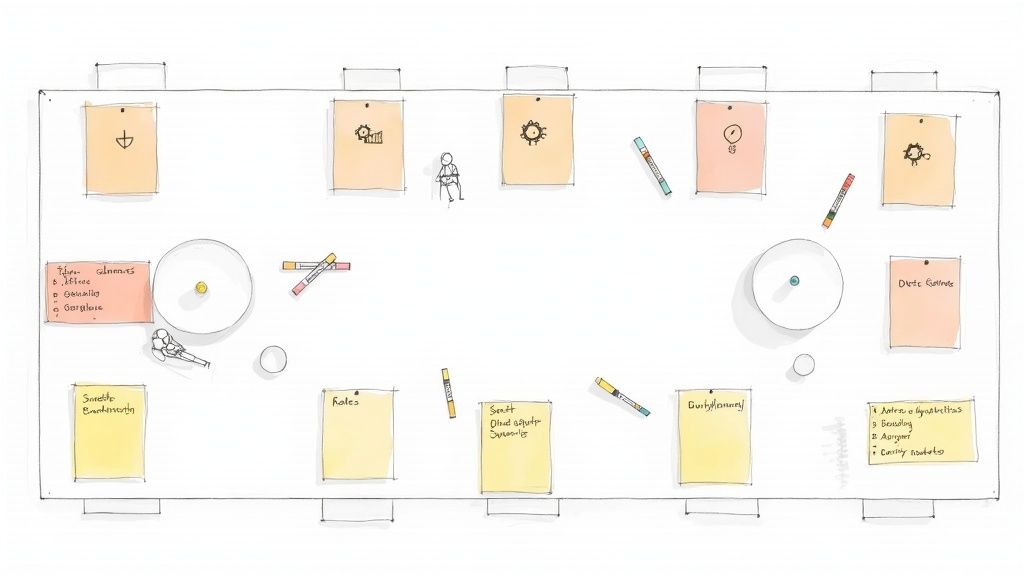


Member discussion